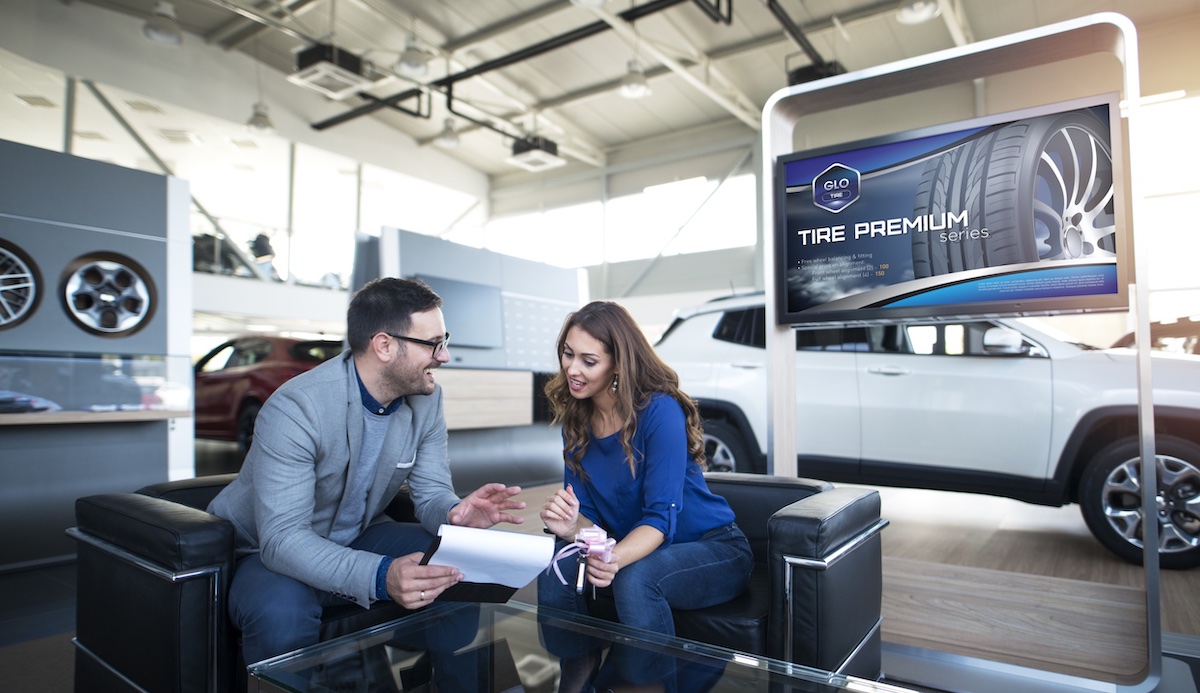
AI And The Other Technologies Helping Shape Experience In Auto Retailing
April 25, 2024 by guest author, Robert Orndorff
Guest Post: Robert Orndorff, Spectrio
 Customer experience, both pre and post sale, has always been at the heart of successful auto dealer operations, and steadily evolving display technologies are an increasingly big part of how those experiences are delivered and optimized.
Customer experience, both pre and post sale, has always been at the heart of successful auto dealer operations, and steadily evolving display technologies are an increasingly big part of how those experiences are delivered and optimized.
Screens in showrooms and waiting lounges are mainstays in most dealer environments, but emerging technologies are poised to both increase and heighten what can be done with screens. When the experience of customers is made better, that tends to influence and close purchases and turn buyers into loyal, repeat customers and ambassadors.
Artificial intelligence, the effective use of business systems data, and emerging display technologies are main keys to how dealers can embrace and profit from technology. They can also help streamline the way vehicle and financial choices are made by customers, and help customers with answers, even when there are more shoppers than staff to help them.
Here are just some of the trends we’re seeing in 2024 for auto retailing:
Smart Messaging
The core benefit of digital signage technology has always been the ability for networked screens to get the right messages, in just the right places, at just the right times. Artificial intelligence makes that premise even more powerful for marketers.
Stock levels, sales figures, market data and other variables can all directly inform and trigger the nature and type of what appears on key screens around showroom environments. For example, what video promotions run on key displays can be tied to lot inventories – emphasizing lower-performing vehicles or new arrivals instead of marketing product that’s unavailable or in short supply.
The same sort of messaging can create personalized congratulations messages on screens when new keys are handed over to buyers, using customer data and schedules. The same approach can dynamically optimize servicing options and high-margin promotions.
Suppose Bob Wilson is coming in for scheduled maintenance at a set time, and his vehicle’s lease term is winding down. Stored data and appointment scheduling, tied in with screen scheduling, can generate messages that nudge Bob to the showroom, to talk about his next leased vehicle.
Smart Interactions
Busy days, vacations, sick leaves and staff shortages can all lead to more potential buyers in showrooms than a dealer can properly handle, risking frustration, or much worse, buyers walking out instead of waiting.
Interactive displays are one way to engage buyers as they wait, in some cases allowing them to start configuring their ideal vehicle. But the dizzyingly rapid rise of AI tools has made much more possible, though, for these kinds of showroom interactions.
Using AI and chatbots trained on every aspect of the product line-up and dealer offers and processes, an interactive screen can have a rich, deep conversation that can steadily define and refine interests, needs and budgets, and take buyers well down the customer journey by the time a sales associate is free.
Multi-Language Interactions
AI has dramatically transformed the idea of using voice instead of physical devices like touchscreens to drive interactions. It may seem like applying technology for the novelty of it – as there’s nothing wrong with touchscreens. But voices drive conversations, and most interestingly, they can deal with language hurdles.
Suppose a couple comes in, hoping to find an SUV that meets their needs and budget. But their first language is Mandarin and their English is limited. Language support learned and loaded into an AI-driven interactive bot can carry on the conversation and product exploration in a preferred language, and give the sales team a set of cues on buyer interests and intentions that aren’t anywhere near as constrained by language hurdles.
An interesting twist is AI bots are also smart enough to cut through accents and get accurate reads on what a shopper is saying, even when a salesperson might be stumped by a thick Yorkshire or Punjabi accent
Controlled Entertainment
Televisions in the waiting lounges of dealers are as common as comfy chairs and coffee machines, but their ability to occupy and entertain customers has always been colored by the inability to control what’s playing.
The classic examples are broadcast commercials that run advertising for competing dealers, and shows selected by waiting customers that please them but irritate, or even, offend others in the immediate area. Partisan cable news channels have sparked complaints and even conflicts between right and left-leaning customers, prompting some dealers to add second TVs, so that everyone is pacified.
A new workaround is empowering dealers with what amounts to their own curated and controlled private label TV channel. Users can build a programming mix for their screens from a diverse range of steadily refreshed lifestyle, entertainment, sports, and children’s entertainment options, and also build in their own promotions (instead of seeing a rival dealer’s ads pop up on TVs!).
Showrooms As Media Facades
Flat panel displays on showroom walls, at service counters and around customer and staff waiting and break areas are increasingly standard components of today’s dealers, but new technologies are emerging that make digital displays part of the overall building’s design and structure.
Modular LED displays now have the quality of visuals, durability and thin, lightweight forms to function as wall finishes. Displays can fill full walls and even wrap around office doors and windows.
There are even companies using 3D printing to create wall panels that look like wood, or wallpaper, or big images, that are backlit and made active using LED display modules in behind. Imagine a feature wall with a landscape scene that’s evocative of a dealer’s location suddenly having active elements, lit up and moving, powered by the hidden LEDs and shining through the 3D printed plastic panels.
The big glass curtain walls common across dealers can also now function as displays – with tiny, barely visible LEDs embedded in the construction glass. With minimal impact on outside views, glass windows enable dealers to market to the lot and beyond.
There are also now films and foils that can be applied to existing glass windows that offer similar visual experiences, though the view outside might be more affected. A Saudi Lexus dealer using that technology has installed transparent screens on a glass window header that’s perhaps 10 feet above the showroom floor, enabling a media façade … but not affecting the view inside or looking out.
Integrating Data
Technology advances, cloud services and tight security controls have combined to allow different business systems to talk to each other and share data. Dealer management systems and related platforms have huge amounts of information that can inform and shape the programming on screens.
Tied to content management systems, the results on screens can be everything from automated pricing changes on service desk menu displays to data-driven, near real-time messaging based on what the core systems are saying about things like inventory levels and sales performance.
Characterizing Activity
AI and machine learning-based audience measurement and analytics software platforms use sensors to log and characterize how consumers use and navigate larger footprint spaces. There are camera-based systems, and also more anonymized, privacy-sensitive systems that pick up the presence of people.
Marketers use these technologies to understand the size of audiences and how long they look at screens and dwell in specific areas, but the same technology can be used in very different scenarios like auto retailing to understand traffic flows, busy and slow periods, and what messages hold viewer attention.
When you understand the dynamics of a venue, the opportunity is there to optimize how things are done – from on-screen communications to how many people are needed on the showroom floor.
Dealer Evolution
The rise of numerous electric vehicle brands and their need to rethink conventional dealer models has implications across auto retailing as a whole. Those new brands are, by design and necessity, very tech-forward, and there are lessons to be learned by much more established manufacturers.
But the big lesson is common across all types – technology has been and will continue to reshape auto retailing. AI, however, is going to accelerate the evolution.
ABOUT THE WRITER
Robert Orndorff is the VP Of Product Management for the digital signage and experiential solutions firm Spectrio. His main focus is on aligning Spectrio’s product strategy and roadmap to enable our customers to deliver engaging solutions that inspire and influence their audiences. Prior to joining the Spectrio team through acquisition, Orndorff was the Chief Innovation Officer of the Automative Broadcast Network, which he co-founded in 2007.



Leave a comment